Class, work, sleep, eat, repeat. That’s an average student’s schedule from Monday to Friday, and it’s easy to feel trapped by its tedium. If you rebel against the monotony, you might watch late-night movies, dance until the sun rises, and eat 25-cent chicken wings. But that just makes you more tired, doesn’t it? When it feels like there’s no way to totally unwind, remember that Sundays were invented for a reason. Today, take some time to put the spring back in your step.
If you need a pick-me-up before yet another jam-packed week, you’ll need more than a day of Netflix and napping. These yoga postures are a sure way to wring out the stress, exhaustion, negativity, and toxic energy that’s been weighing on your body. Plus, there’s a bonus in today’s routine for all of you lazy daisies: You won’t even need to get out of bed to get started. Gather two of your finest pillows and put on some comfy clothes for these revitalizing stretches.
Half Knees to Chest Pose (Ardha Apanasana)
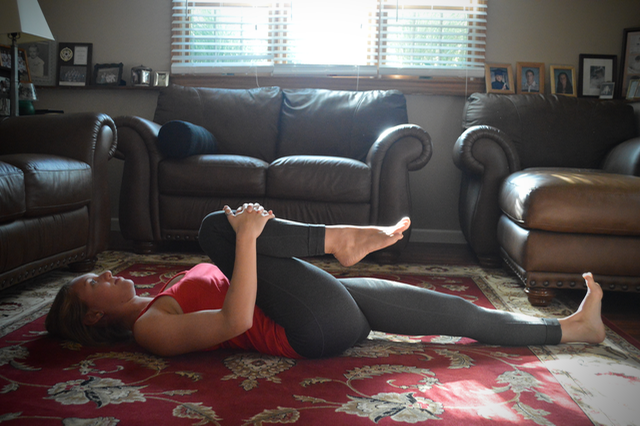
Certified yoga instructor Jeanine Donohue practicing half knees to chest pose (Katelyn Brush)
This pose will compress the internal organs, allowing your body to release what it needs to in order to feel good again. Essentially you’re massaging your abdominal muscles, digestive organs, and ascending and descending colons. That being said, be cautious if your stomach is not its usual self.
How to:
Lie down flat with your shoulders and the back of your neck grounded. To keep the neck flat, you can use a thin pillow or blanket to tuck your chin into your chest slightly. Bring one knee into your chest, interlacing your fingers just below the knee and pulling your leg away from your rib cage and toward your armpit. The leg that is left long should be engaged, so flex that foot while breathing into this posture and pulling your knee in closer to your armpit. When you finish, switch sides!
Benefits:
- Stretches the glutes, hamstrings, and groin
- Relieves tension in the lower back
- Strengthens the arm muscles
- Improves digestion and elimination
Reclining Spinal Twist (Supta Matsyendrasana)
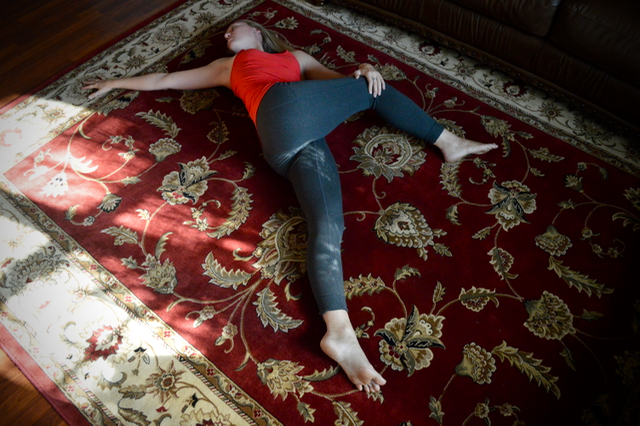
Jeanine Donohue, certified yoga teacher, in a reclining spinal twist (Katelyn Brush)
Also known as the supine twist, this posture is good for compressing and squeezing out the stressors and toxic energies of the day. Twists, like this one, will also hydrate the spinal disks, which is great for individuals who spend hours sitting at a desk. The twist will also detoxify the organs in your torso, which can be good if you’re in the habit of drinking alcohol or eating unhealthy foods.
How to:
Begin lying down with your shoulders flat on the ground and chin slightly tucked so that your neck is supported by the ground (or your bed, if you’re still in it). Bring the first leg—let’s start with the right—into your chest by using your left hand to hug the knee in close to your body. Then, use your left hand to guide your right leg across your body. Allow your right hip to lift as you extend the right arm (palm facing down) in the opposite direction of the leg. Bring your gaze over your right hand so that the twist can move through your spine into your neck. Lie here for five breaths.
You must do this posture on both sides. In order to register the realignment physically (resetting the spine and neck) and mentally (getting those feel-good vibes roaring), lie flat and take a few deep breaths through your nose and out of your mouth after each set.
Benefits:
- Stretches the back muscles, glutes, and neck while gently opening the chest
- Hydrates the spinal disks
- Realigns the spine while also lengthening and relaxing it
- Massages the digestive organs, back, and hips
- Releases tension in the psoas muscle and SI joint
- Detoxifies and calms the body with the twist
Knees to Chest Pose (Apanasana)
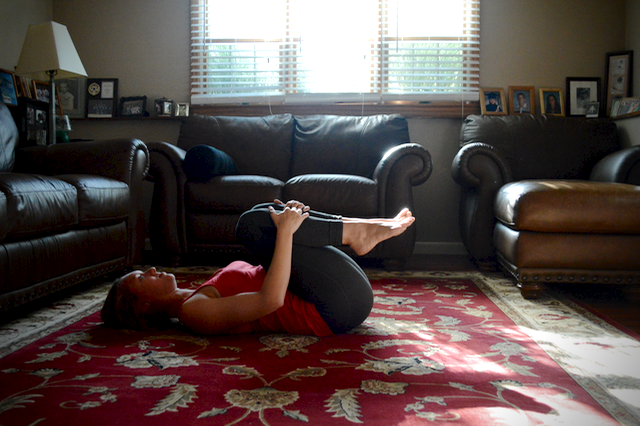
Yoga teacher Jeanine Donohue practicing knees to chest pose (Katelyn Brush)
Also known as the wind-relieving pose, this position is the full expression of the first posture in this article. It’s just as important to protect your neck and spine in this variation as it is in the first.
How to:
Tuck your chin into your chest slightly so that your neck is supported. If you’re on a flat surface that makes this challenging for you, place a blanket or thin pillow behind your head. Bring both knees in on top of your chest. Hug your legs beneath your knees and squeeze them into your torso. Then, rock side to side in order to massage your back.
Benefits:
- Stretches the glutes and hamstrings
- Relieves tension in the lower back
- Strengthens the arm muscles
- Improves digestion and elimination
Legs-Up-The-Wall Pose (Viparita Karani)
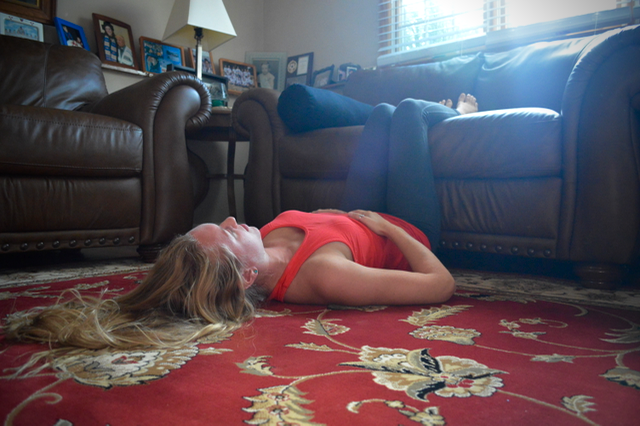
Jeanine Donohue, certified yoga teacher, in a legs-up-the-wall yoga posture (Katelyn Brush)
The name is literal, and the posture is incredibly relaxing. You don’t need a wall if you can stretch your legs straight up toward the sky without support. However, if you do use the wall, you can slowly deepen the stretch.
How to:
First, make sure your props are nearby. If you’re planning to hang out with your legs up for a while, you might want a support pillow or blanket for your hips or your neck. Lie on your side with your hips close to the wall and knees tucked in toward your chest, then roll onto your back while lifting your legs to bring the backs of them against the wall. Find a comfortable spot for your supports and a suitable distance between your hips and the wall. The tighter your legs are, the farther your hips should be away from the wall. Adjust accordingly, then stay for as long as you’d like. If your feet get tingly, slide your feet down the wall.
Benefits:
- Stretches out the hamstrings, lower back, and neck. (If you have stacked some pillows beneath your hips, you will have a chest stretch as well.)
- Calms and focuses the mind while relieving mild forms of stress, anxiety, and depression
- Relieves mild neck and back pain
- Therapeutic for cramps, insomnia, exhaustion, headaches, migraines, and digestive problems
Child’s Pose (Balasana)
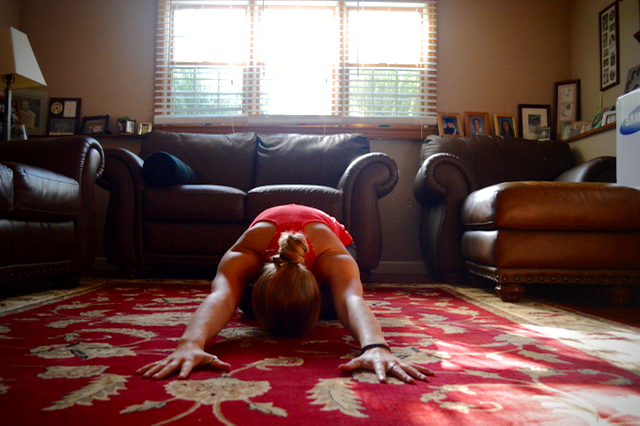
Jeanine Donohue practicing child's pose to detox from a long week (Katelyn Brush)
There are easily a dozen reasons why child’s pose is the crowd favorite. Though, if your stomach isn’t feeling too hot this morning, you may want to ease yourself into this posture since it tends to get the digestive organs working. You may decide to stretch out over a pillow, which will soften the compression on the internal organs and lengthen the spine more. If you struggle getting into the posture, you can also place a pillow on top of your calves and sit down on that.
How to:
Keep your big toes together with the tops of your feet flat on the floor. For more compression on the torso, keep the knees together. To stretch and open the hips (or if you have sensitive knees), separate the knees, but don’t forget to keep the toes together! Now, pull your hips back toward your heels while lengthening forward through the fingertips. Bring your forehead to the floor (or to the pillow if you placed one beneath you) to relax as you begin to focus on your breathing.
Benefits:
- Stretches the hips, thighs, glutes, feet, and ankles
- Relieves stress, anxiety, dizziness, and fatigue
- Deepens and steadies the breath
- Calms the nervous system by bringing blood flow to the brain
- Allows the body to relieve stress and tension
Revolved Child’s Pose (Parsva Balasana)
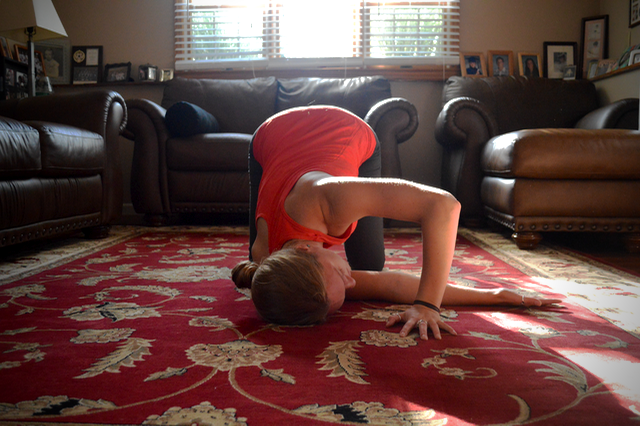
Certified yoga instructor Jeanine Donohue in a revolved child's pose (Katelyn Brush)
From the ever comfy child’s pose, rise up to your hands and knees, forming a tabletop position where your knees are beneath your hips and your wrists are beneath your shoulders. This is another posture where, if you want to make it really zen, you can place a pillow beneath your torso.
How to:
While keeping your hips lifted, reach your right arm all the way up, pulling backward through the right scapula, while bringing your gaze toward the ceiling. Then, sweep the right arm underneath your body, through the space between the left hand and knee. Reach that right hand as far as you can and slowly soften the left elbow, pulling it in toward the rib cage until it is bent enough for you to rest the right side of your face and right shoulder on the ground. This pose is also known as the threading the needle pose. Seems fitting, right? From there, you can extend the left arm forward, pulling back through the left scapula.
Benefits:
- Opens the shoulders
- Compresses the muscles in the upper chest
- Increases blood flow to the upper extremities and the brain, thereby calming the nervous system
- Detoxifies and calms the body
Downward-Facing Dog (Adho Mukha Svanasana)
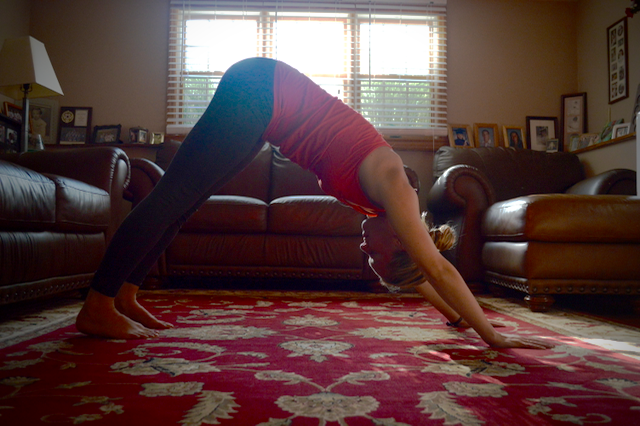
Certified yoga teacher Jeanine Donohue practicing a downward-facing dog posture (Katelyn Brush)
Fair warning: You’re at the end of the road, and it’s nearly time to get out of bed. From your revolved child’s pose, come back into a tabletop position and prepare for downward-facing dog.
How to:
Take a moment to grip with your fingertips. This will ensure that your wrists sustain less pressure thanks to proper distribution of weight. Now, tuck your toes, press into your heels, and lift your hips as high as they’ll go. Picture your body as an upside-down letter V. Walk out your feet to stretch your calf muscles by pressing one heel down and bending into the opposite knee.
Benefits:
- Stretches the hamstrings, shoulders, chest, ankles, arches, and hands
- Strengthens the arms and legs
- Calms and focuses the mind
- Energizes the body
- Relieves headache, insomnia, back pain, and fatigue
Now
Come to a standing position by walking your feet toward your hands and stretching all the way up. Think happy thoughts. Take a moment to close your eyes and say a little prayer or mantra before starting your day. In yoga, we use intentions to guide us through challenges, whether they are physical or mental. The intention is what you make of it. Create a mantra that illustrates a reminder or thing that you need to help you get through the day. Here are some examples:
- Be productive, be patient, be present.
- There is no other time than now, and I am ready.
- I am whole. I am love. I am enough.
- I am ______ (insert what you want to be).
-
Six Yoga Poses to Help with Anxiety and Panic Attacks
-
How to Keep Your Brain Active Over Summer Vacation
-
Yoga: An Energizing Practice for Beginners
-
The Truth: Why You Should Get Fit to Finish the School Year
-
Easy Ways to Stay Fit When You’re Busy with School
-
How to Be Smart in Our National Parks This Summer
-
Why I Joined and Why I Quit: A Softball Story
-
Eight Ways to Stay Fit during the Winter Months without Hitting the Gym
-
15 Ways to Avoid Gaining the Freshman 15

